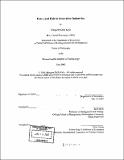| dc.contributor.advisor | Scott Stern. | en_US |
| dc.contributor.author | Kyle, Margaret K | en_US |
| dc.contributor.other | Massachusetts Institute of Technology. Dept. of Economics. | en_US |
| dc.date.accessioned | 2005-08-23T20:00:14Z | |
| dc.date.available | 2005-08-23T20:00:14Z | |
| dc.date.copyright | 2002 | en_US |
| dc.date.issued | 2002 | en_US |
| dc.identifier.uri | http://hdl.handle.net/1721.1/8414 | |
| dc.description | Thesis (Ph.D.)--Massachusetts Institute of Technology, Dept. of Economics, 2002. | en_US |
| dc.description | Includes bibliographical references. | en_US |
| dc.description.abstract | The central theme of this dissertation is that the interaction between firm characteristics and market characteristics is crucial to understanding the evolution of market structure, competition, and firm behavior. I integrate ideas from industrial organization and strategic management in an empirical examination of two innovative industries: pharmaceuticals and laser printers. Chapter 1 provides an overview of this work and discusses its broader implications. In Chapter 2, a range of econometric models for a firm's decision to launch a new pharmaceutical product in 21 OECD countries is estimated. The results suggest that the interaction between the innovating firm, drug, and target country is a critical component of profitability, and that regulations may not affect firms and products uniformly. Chapter 3 considers how entry is influenced by the characteristics of incumbent firms and other potential competitors in a subset of pharmaceutical markets. In an extension to previous structural entry papers, this work explores the effect of competing with other firms that might have an asymmetric effect on profits. Chapter 4 examines the roles of market structure, product characteristics, and firm characteristics in explaining patterns of product entry and exit in the desktop laser printer industry. I find that firms with complementary assets are less sensitive to competition from similar products than are firms without these assets. Not only do the products of complementary asset firms survive longer, but such firms are more likely to introduce new products in crowded market segments. | en_US |
| dc.description.abstract | (cont.) Firms without complementary assets tend to introduce new products close to the technological frontier. However, their products exit earlier than those of complementary asset firms. These two types of firms appear to pursue different product market strategies, and the mix of both drives the product life cycle. Understanding entry and exit in these settings may provide insights into the diffusion of other new technologies, because pharmaceuticals and laser printers have a number of features in common with other industries of great interest to managers and policymakers at the moment. Thus the insights from this dissertation may be applicable to broad sectors of the economy. | en_US |
| dc.description.statementofresponsibility | by Margaret Kelly Kyle. | en_US |
| dc.format.extent | 142 p. | en_US |
| dc.format.extent | 10517685 bytes | |
| dc.format.extent | 10517445 bytes | |
| dc.format.mimetype | application/pdf | |
| dc.format.mimetype | application/pdf | |
| dc.language.iso | eng | en_US |
| dc.publisher | Massachusetts Institute of Technology | en_US |
| dc.rights | M.I.T. theses are protected by copyright. They may be viewed from this source for any purpose, but reproduction or distribution in any format is prohibited without written permission. See provided URL for inquiries about permission. | en_US |
| dc.rights.uri | http://dspace.mit.edu/handle/1721.1/7582 | |
| dc.subject | Economics. | en_US |
| dc.title | Entry and exit innovative industries | en_US |
| dc.type | Thesis | en_US |
| dc.description.degree | Ph.D. | en_US |
| dc.contributor.department | Massachusetts Institute of Technology. Department of Economics | |
| dc.identifier.oclc | 50602020 | en_US |
